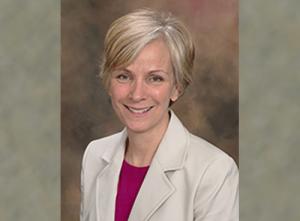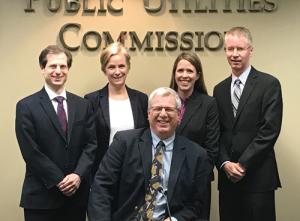Nancy Lange, Chair, Minnesota PUC
PUF: What do you do in a typical day?

Chair Lange: As Chair, I lead the commission's decision-making process at our agenda meetings, provide administrative oversight to the agency, and devote time to reviewing the record in the dockets that come before us.
Our Commission has five appointed commissioners and we meet every week to make decisions on matters related to electric, gas and telecom utilities. Minnesota has open meeting requirements, so each week we deliberate in public, and we make our decisions in public. As Chair of that process, my job is to facilitate sound decisions and with our five engaged commissioners, it's a fascinating aspect of the Chair's job.
In my administrative role, I work with our Executive Secretary to make sure that our budgets are in good shape, our staffing is adequate, and that we are capable as an agency of meeting the needs that we have in front of us as a regulatory body.
PUF: Is it like a FERC meeting, in that you talk things out in public?
 From left to right, Minnesota PUC Commissioner Dan Lipschultz, Chair Nancy Lange, Commissioners John Tuma, Katie Sieben and Matt Schuerger.
From left to right, Minnesota PUC Commissioner Dan Lipschultz, Chair Nancy Lange, Commissioners John Tuma, Katie Sieben and Matt Schuerger.
Chair Lange: By law we are prohibited from having dialogue with fellow commissioners about pending decisions. We wait until we get into the hearing room, we ask questions, deliberate and then reach decisions.
As we work through our decisions in the hearing room, it can take some time and requires advocacy with your fellow commissioners to get alignment around the decision. It's a very dynamic process and makes for interesting deliberations. I strive to achieve consensus decisions where possible, because when the commission can speak as a unified body on matters of policy or ratemaking, that's always preferred.
PUF: What's your take on the electric power industry?
Chair Lange: We're experiencing evolutionary change in the electric utility industry. While the pace and scale of that evolution might vary across the U.S., the markers of significant change are present in all states.
I offer three examples of what represents a real change in the industry. The first would be the evolution away from higher operating cost resources to low marginal cost resources, which also happen to be lower or zero carbon resources.
If you think about renewable energy or energy efficiency, or even the falling prices for natural gas, these resources are driving down the marginal costs to supply energy. Our regional energy markets are based on marginal cost pricing.
Energy markets enable this transition for cost efficiency, but at the expense of some of the legacy resources with higher operating costs. Coal and nuclear plants are the most obvious examples.
That is a significant change. You can see the debate within the DOE and FERC on this issue, within RTOs and in individual states. But there's no doubt that the proliferation of many low marginal cost resources is evolving the system pretty quickly. In Minnesota, we're seeing this evolution in our electric utilities' integrated resource plans. Wind is currently the most cost-effective energy resource.
PUF: Wind is really economic.
Chair Lange: Yes. The technology performance continues to improve while the costs continue to decline. The impact on the utilities' system and on regional markets is going to continue to change things up.
Another example of this industry evolution is passive customers becoming much more active customers. The signals are clear that customers are "flexing their preferences." We're moving from customers that primarily focus on attributes of price and reliability alone, to customers that are looking at different choices. And they are going out and getting those choices one way or another.
They're asking for new products and services from their utilities. In some places, customers are finding service outside of their incumbent utility. A recent statistic showed that the majority of new renewable PPAs are now with private customers as opposed to utilities. In Minnesota we see communities setting climate and energy goals, and they want their utility to help them meet these goals.
In some states, you see community choice aggregation pulling entire communities out of the utility system. To my thinking, it's critical that customers stay connected to the grid, supporting the overall economics of the utility system and even serving as grid resources to the system. Keeping customers connected and satisfied is a high priority for regulators and utilities.
Another example of the evolutionary trend is the centralized utility system evolving to a more decentralized model. This shift is driven by the proliferation of energy and data technologies that enable a more decentralized system and also by policies that are coming from states, RTOs and even FERC.
In the years ahead, the application of data is going to be a central question for regulators and utilities alike. While the use of energy data holds enormous promise, it will continue to challenge regulators to understand its application, how to safeguard it, and who gets access to what data.
Those are three examples of evolutionary shifts that I see from my vantage point, both at the Minnesota commission and also as chair of NARUC's Energy Resources and the Environment Committee.
PUF: Would you characterize the current situation as change in a lot of different directions?
Chair Lange: Certainly, the pace and scale of change varies regionally and by state. In some states you have policies driving that change at a faster rate, and in some restructured states you have markets that can either drive that change or impede that change. In Minnesota, a vertically integrated state, there is a more stable trajectory as opposed to rapid shifts in the industry.
We continue to advance good planning tools to make regulatory decisions in light of these changes. These tools include integrated resource planning, and we're instituting new distribution system planning requirements for the electric utilities.
These important planning tools allow the commission to examine investments utilities are making and the impact on total system costs and the capabilities those investments will produce. It allows us as a commission to guide this evolution in a way that's cost efficient, equitable, and produces resilient, reliable service.
We have encouraged new pilot projects. These pilots allow utilities to test new approaches, such as time of use pricing, and evaluate the benefits before the full-scale rollout. Pilots allow commissions to advance new regulatory approaches before instituting wholesale reform.
PUF: If you can look out, say, three to five years, do you feel optimistic about where the industry will be and Minnesota in particular?
Chair Lange: I am optimistic about where the industry is headed. In Minnesota, we've been able to add significant amounts of no or low carbon resources at a very attractive price point. We are starting to test and pilot new innovative services for customers, and our utilities are beginning to work with third party innovators.
The kinds of customer services that are going to emerge in the next three to five years aren't just going to emerge from within the utility industry, so that collaboration between utilities and third-party innovators is important.
On the side of caution, however, I am very aware that all the investments needed to upgrade aging infrastructure as well as add new resources, technologies and services is an expensive undertaking - billions of dollars of projected investment in Minnesota alone. So it's on us as regulators to ensure that the purpose and timing of these investments is prudently executed.
PUF: You were hinting that there's a big role to play, in the leadership role from the commission, in guiding things in the right direction.
Chair Lange: I agree that we play a central role in guiding the evolutionary track of the utilities in our states. While stability is an important attribute of the utility industry, the drivers of change are not going away. So utility commissioners must ensure the evolving system is a cost efficient, reliable and equitable system and that it works for all customers.
State and Future of Power articles:


